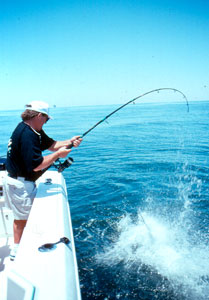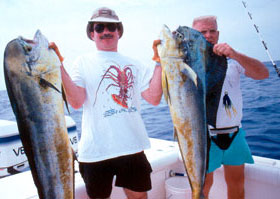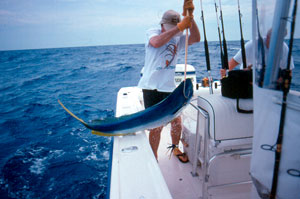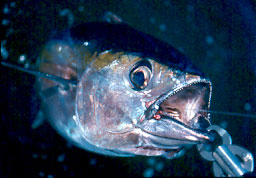The scenario is repeated all too often: An angler hooks a huge fish and manages to battle it close to the boat. With the fish in plain view, the excited helmsman shifts the boat into neutral, grabs a gaff and rushes to assist in the landing duties. With the boat dead in the water and a major celebration a mere gaff or net swipe away, the fish suddenly charges forward and the hook pops loose. Shocked and disappointed, the fishermen can only watch as their prize swims off into the depths.

Ray McConnell at Ray's Offshore Fishing Tackle in Boca Raton, Florida has heard that same sad tale many times. He says that one of the biggest mistakes novice fishermen make when bringing a large, powerful fish to gaff is not using the boat to their advantage. "Many people fail to realize that they must keep the boat moving forward when leading a fish in, "says Ray. "This eliminates slack in the fishing line and reduce the chances of the hook falling out. You can also control the fish much better and lead it right to the gaff because it will continue swimming along with the boat. However, if the forward momentum stops you'll be vulnerable to those last-second charges."
Starts with the Strike
According to Ray, successfully landing a fish actually begins with setting the hook. He's a big proponent of using a firm strike drag that drives the hook home from a distance. "I'll watch customers pull line off a reel with their hand and say the drag's too tight, when in reality it's not," says Ray. "In some situations, I believe hooks pull out because the anglers are fishing with too light of a drag. Instead of guesstimating, they should use a scale to set the drag at 1/3 of the line's breaking strength on a straight pull. Plant that hook solidly and there will be less chance of the fish shaking it loose. The drag can always be reduced if a fish is taking a lot of line, but it's important to first set the hook firmly."
Other hook-setting strategies include keeping the boat moving after a strike. This helps remove the stretch from monofilament line and often leads to multiple hook-ups, since the remaining baits continue to skip and swim. Plus, there's no sudden change in engine rpm to startle companion fish. As a general rule, maintain your trolling speed for about 30 seconds after the initial hook-up before pulling the throttles back.

When setting a hook from an anchored or drifting boat, continue reeling for several seconds as the fish surges or swims away. This helps drive the hook home by removing any stretch from the fishing line. After a positive hook-set is achieved, you can settle into your normal fighting pattern.
Fight 'Em Right
The best light-tackle anglers are masters at establishing a fighting rhythm that quickly exhausts their quarry. When the fish suddenly charges off, these pros react by immediately relieving pressure. When the run ends, they reapply the pressure and steadily regain line. The object is to let the fish wear itself out, not bully it. This tactic also works when using heavy tackle in conjunction with small, light-wire hooks that can straighten or tear out under heavy pressure, or when fighting fish with soft mouths. Although extra elbow grease will be required at times to keep a fish away from structure, the main objective is to establish a smooth give-and-take rhythm that will ultimately tire the fish.

Maintaining your fighting rhythm during the battle's final stage is of utmost importance. When lulled by a steady pace, a tired fish can be led to the boat quite easily. However, should the rhythm be altered by someone grabbing the leader or the angler applying additional pressure, the fish will often react by thrashing violently, charging off or jumping. It's at this stage that anglers and fish often part ways.
The Wind-On Advantage
Once designed exclusively for 50- to 130-pound-class gear, long wind-on leaders are now available for 20- and 30-pound tackle. They're ideal for helping offshore anglers maintain their fighting rhythm and lead a fish alongside the boat unassisted.
The line-to-leader connection should feature a small, streamlined knot such as the Bristol, Albright or Surgeon's that passes easily through the rod guides. Spro barrel swivels, which are impressively small and strong, are becoming a popular option for joining leaders to light line. Many pros are now using them with heavy offshore tackle because of their strength and diminutive size, as well as their ability to be wound easily through the guides and onto the reel.
Ray McConnell points out that teamwork between the angler and his crew member(s) often play a critical role in the landing of a fish. "When a fish is brought near the boat, an angler tends to hold the rod high and take a few steps back from the gunwale to lead the fish to the gaff or net man," says McConnell. "That's fine, as long as the angler is disciplined enough not to move forward to take a look at his fish before it can be gaffed or netted. Doing so could allow the fish to swim a few feet out of reach. In desperation, the gaffer may take a risky shot. In some cases the gaff may stick lightly and pull out. Or the gaff man may jeopardize his ability to swing the fish over the transom in one smooth motion. And if the gaff hasn't been planted correctly in the head section, he'll be holding a wildly thrashing fish. Little things like that make a difference."
Whenever I'm leading a fish to the boat, I always prepare myself for any last-second surges. I do this by backing off the drag by 50 percent and applying firm thumb pressure to the spool once someone has grabbed the leader. I also tell the leader man to release the leader if the fish makes a last-second run, rather than risk pulling the hook. Should the fish suddenly take off, I drop the rod tip and let the fish swim off against the light drag. Once the fish is clear of the boat, I advance the drag and play it back it.
Gaff and Net Moves
Should you decide to keep your catch, netting or gaffing it is the next challenge. When gaffing, the general procedure is to target the upper shoulder or head region, which enables you to lift the fish's head from the water and hoist it into the boat in one sweep. Control of the fish diminishes the farther back it's gaffed, and you'll also damage the meat.

You don't need to swing a gaff with the intensity of a baseball bat. Rather, slip the gaff hook under the fish and simply lift straight up. You'll be amazed at how easily it sets. From there, swing the catch into the fishbox with a smooth motion, remove the gaff as soon as the fish hits the ice, and slam the lid shut.
When netting, the angler should lead the fish into the mesh (never try to net a fish from behind!) As the fish swims into the net, the angler should dip his rod to create enough slack so that his line won't interfere with the lifting of the net.
The procedure is much the same when using a lip gaff or a lip-grabbing device like the BogaGrip. With the former, lead the fish to boatside and insert the gaff hook inside the mouth and out the lower jaw. To control a large fish, you can pull the point of the lip gaff tight to the underside of the boat's rubrail. With a BogaGrip, place the pincers around the fish's lip and allow them to snap shut. The weight of the fish keeps the pincers locked around the lip. This handy device not only prevents the removal of protective slime, it also features a scale that allows you to weigh your catch prior to release.

As basic as they may seem, remembering these pointers when you hook up with that next big fish could ensure your coming home with the goods. If you're like the rest of us, the last story you want to tell is how painfully close you came to landing a real monster!

